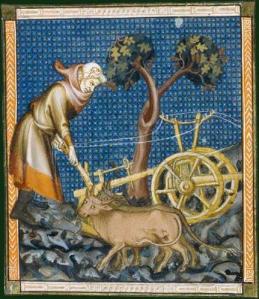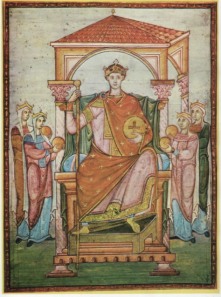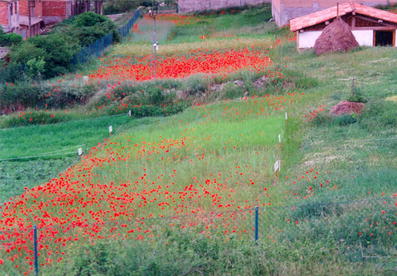Somehow I am staying ahead this semester. Having known for more than a week that I’d be teaching this time, I had lectures prepared a full fortnight ahead at the time of writing, lectures that are simpler and hopefully more effective than last semester’s, and therefore quicker to build; and consequently I am also finding time to do some actual work (as well as, as you will have noticed, blog a load of stuff).1 Specifically, I have started the background work for my Kalamazoo paper, for which I foolishly promised something that would actually require research, and by now I have an idea what shape it will be and what two of its jokes are, which is, surely, half the battle. I may not have read any of the substantive information I need to do it properly, but I know that if I absolutely had to I could already pull something together and this is very encouraging. (Incidentally, could someone who has my e-mail address and a digital copy of the Kalamazoo programme mail it me? I’ve tried from work and from home and I can’t download it, the operation hangs or fails with an error. Thanks in advance.)

Professeur Pierre Bonnassie (d. 2003) at the Universitat Autonòma de Barcelona, 1993
It has also led me to be reading Pierre Bonnassie’s Festschrift, which I mentioned a while ago, and consequently to be thinking (even more) about peasants and the good ol’ feudal transformation. If you’ve met Bonnassie’s work at all you’ve probably met it where he argued that between the end of large-scale agricultural slavery in late Antiquity and the development of serfdom in the years just after 1000 (for him) there was a sort of sweet spot, briefly enjoyed, where the majority of peasants were basically free, even if under public lordship.2 Obviously this only really works in South-Western Europe (‘du Rhône à Galice’) and buckets of cold doubt have been cast on it even there, but as with many of Bonnassie’s theories it still looks basically defensible in Catalonia, where the open frontier gives peasants somewhere to run to and lords, therefore, a reason to be nicer than they might otherwise be so that the peasants don’t run there.3 The debate there swirls around the effects of this. Does the peasant freedom to seek their own fortune in new lands on the frontier account for economic dynamism, increased land clearance and all that unfolds therefrom? Or is that instead driven by the pressures of lordship on the peasants once newly subjected? Chris Wickham finds an ingenious halfway house, arguing that to see peasants as venture capitalists starting small businesses is woefully anachronistic, that left to themselves peasants would not work to raise their lands’ output (“peasants had two alternatives, to eat more or to work less, and I suspect that they did both”) and that although the pressure to improve therefore comes from the renewal of oppressive lordship the peasantry still deserve credit as the innovators who had to work out how to come up with, quite literally, the goods.4
The other debate that springs from this is on the rôle of technique and technology. Bonnassie argued, on the basis largely of Lynn White’s book, that in the run up to 1000 peasant equipment was getting better: the heavy plough had finally made it to the area, iron tools were more and more common and watermills were newly prevalent.5 Subsequent work, however, has suggested that the heavy plough is basically irrelevant to the average Catalan homestead, where there wasn’t really room to turn it round and the soil is light anyway; that there’s no reason why iron tools should have been more available, since the techniques of smelting don’t change for a few centuries more, so this must actually be effect not cause, the cause being richer peasants; and that watermills are common much earlier, but don’t then seem to have this effect.6 (Also, of course, when most of your documentation comes from a recently-reorganised and expanding frontier zone, almost all infrastructure takes a while to set up, so it’s the wrong place to look for the agricultural state of the art as it will be late; but it’s where most of the documents come from.) The counter-argument, therefore, is that rather than being propelled by innovation or better techniques, the agricultural growth here was a slow buildup of the occupation of newly-cleared land, which was worked in the same way as ever but slowly increased, therefore fed more people who would occupy more land and so on till, boom, exponential growth.7 And if that’s so, then in my opinion the change has to start with the climate, but you’ve read me on that score already.
Two of Bonnassie’s contributors engaged with this question in the best way, that is, from the archæology, and produced almost opposite nuances of his approach. Firstly, Jean-Paul Cazes tells the readers about underground grain silos at what appears to be his pet area, the Lauragais in Southern France.8 The thing here is that these perfectly unremarkable dug-out spaces in the ground, which stand out really well as crop-marks, only show up there associated with Roman-period settlement or sites of the ninth century or later. Identifying sites in that gap is of course tricky, tricker than Cazes allows in the small space the contributors seem to have been allowed, but all the same the association is pretty striking, and he argues that it means that the agricultural growth here was local, that is, the peasants were newly able to keep their surplus locally rather than having to render it up to the royal vill or similar as we are told they would have done in the Carolingian era. That is, there may or may not be growth testified in this but there is certainly a relaxation of exploitative authority. It’s a fascinating way of demonstrating what the master who was being fêted had asserted from documents alone.

Medieval peasant at work with a hand plough, from a manuscript in the Bibliothèque National de France
Then, in the immediately following article, Aline Durand tackles the question of how these peasants actually set about working the land.9 In an article that covers a huge amount of ground in a very short space, Durand inventories the tools that later Toulousain documents suggest a peasant was expected to turn up to do his labour service with, and that wills and so forth suggest that they owned, and argues that whereas big estates calling on large labour pools would have ox-teams and heavy ploughs the peasant working his own land would have used an ard or a hoe for most of the work and a hand-plough like the one above, probably not even with wheels, to till his small and light-soiled fields. Durand thinks these tools would have had iron blades, which is where Bonnassie saw the change; Durand’s sources are later so Bonnassie could still be right (and Durand was hardly going to choose this venue to say otherwise). I don’t know where we are with this now: if there is an Owlfish reading, they may be able to add perspective. However, Durand, not content with this short tour de force, observes that while the tools don’t seem to change as some paradigms would argue, field use does: she notes that seigneurial labour levies operate on three ploughings a year, one to break up the sod, one immediately preceding the sowing and another to bury the stubble. This third one, she says, was largely skipped by people working their own land, as far as we can tell; this is after all back-breakingly hard work, especially if you’re doing it as above rather than with an ox-team. However, she suggests that once the model and its superior productivity (because it refreshes the soil) was widely observable people would start to use it on their own lands.
This part of the argument is to say the least unproven, because of course her primary sources are documents of lordship so showing what’s going on on land that aren’t under lordship, at least that directly, is hard to do. Also, it conflicts with her own reason why this wasn’t happening earlier, viz. that peasants didn’t want to do the work. They would rather eat more and work less, as Chris has it. But a more subtle metric of competition might explain a new pressure to produce surplus for both groups, I suppose. Either way, these papers match each other quite well, Cazes showing that apparently peasants were keeping more of their crop than before and Durand showing that crops are being made larger than before by technique, and not just extra land being used. In this respect they fortify their master well, and show his own impressive ability to bring unexpected forms of evidence to bear in support of his initially charter-based claims.10 Whether the causation should run surplus, therefore increased extraction, therefore pressure to grow more, as Wickham would want it, or increased extraction therefore surplus, as I think Bonnassie would have, however, I’m less sure. I might, in the end, side with Gaspar Feliu and others like him and gloomily conclude that the option in which the peasants lose out is probably the more likely.11
1. Of course, all this progress comes at the cost of anything that might be mistaken for a life, but since that was also the case last semester when I was hanging onto my deadlines by the skin of my teeth, I’m still winning.
2. Classically in Pierre Bonnassie, “Survie et extinction du régime esclavagiste dans l’occident du haut moyen âge (IV-XI s.)” in Cahiers de Civilisation Médiévale Vol. 28 (Poitiers 1985), pp. 307-343, transl. J. Birrell as “The Survival and Extinction of the System of Slavery in the Early Medieval West, fourth to eleventh centuries” in Bonnassie, From Slavery to Feudalism in South-Western Europe, transl. J. Birrell (Cambridge 1991), pp. 1-59.
3. So maintained, for example, in Paul H. Freedman, The Origins of Peasant Servitude in Catalonia, Cambridge Iberian and Latin American Studies (Cambridge 1991).
4. Chris Wickham, “Problems of Comparing Rural Societies in Early Medieval Western Europe” in Transactions of the Royal Historical Society, 6th Series Vol. 2 (Cambridge 1992), pp. 221-246, rev. in idem, Land and Power: studies in Italian and European social history, 400-1200 (London 1994), pp. 201-226. Quote is near the end as I recall.
5. Pierre Bonnassie, La Catalogne du milieu du Xe à la fin du XIe siècle : croissance et mutations d’une société (Toulouse 1975-1976), 2 vols, I pp. 435-475, esp. 459-475, largely on the basis of Lynn T. White, Medieval Technology and Social Change (Oxford 1962).
6. For the plough arguments, not made explicitly for Catalonia but clearly applicable, see Norman Pounds, An Economic History of Medieval Europe, 2nd edn. (London 1994); on iron-smelting I admit my understanding has been recently updated by the comments on this blog-post at Armarium Magnus, which contain references, at least the ones I was interested in did; and on earlier mills you might be best advised to see, if you only could, if I only could, etc., Jonathan Jarrett, Rulers and Ruled in Frontier Catalonia 880-1010: pathways of power (London forthcoming), Chapter probably-3 about Roda de Ter. Also some useful perspectives in C. Arbùcies & J. Oliver, “Vinyes que ja no hi són. Per una arqueològia agrària del domini feudal del treball pagès: les vinyes de Sorre, Montardit (el Pallars Sobirà) i Musser (la Cerdanya)” in Immaculada Ollich i Castanyer (ed.), Actes del Congrés Internacional Gerbert d’Orlhac i el seu Temps: Catalunya i Europa a la Fi del 1r Mil·lenni, Vic-Ripoll, 10-13 de Novembre de 1999 (Vic 1999), pp. 321-337.
7. For a range of views on this issue, and others, mainly focussing on whether or not Robert Fossier was wrong about it, try Georges Duby (coord.), “Table Ronde” in La Croissance Agricole du Haut Moyen Âge : chronologie, modalités, géographie. Dixième Journées Internationales d’Histoire, 9, 10, 11, Septembre 1988, Flaran Vol. 10 (Auch 1990), pp. 181-203. Fossier argues that he wasn’t, as you’d expect. Contrast Bonnassie’s contribution to the volume, “La croissance agricole du haut moyen âge dans la Gaule du Midi et le nord-est de la péninsule ibérique : chronologie, modalités, limites”, ibid. pp. 13-35.
8. J.-P. Cazes, “Les silos et leur significance dans le haut moyen âge. L’exemple du Lauragais” in Hélène Débax (ed.), Les sociétés méridionales à l’âge féodal (l’Espagne, Italie et sud de France Xe-XIIIe s.). Hommage à Pierre Bonnassie, Méridiennes 8 (Toulouse 1999), pp. 45-50.
9. A. Durand, “La labour de céréaliculture en Languedoc méditerranéen (Xe-XIIe siècles) : quelques points de repères”, ibid. pp. 51-56.
10. For example, see his reply to Dominique Barthélemy in Bonnassie, “Nouveautés linguistiques et mutations économico-sociales dans la Catalogne des IXe-XIe siècles” in Michel Banniard (ed.), Langages et Peuples d’Europe : cristallisation des identités romanes et germanique. Colloque International organisé par le Centre d’Art et Civilisation Médiévale de Conques et l’Université de Toulouse-le-Mirail (Toulouse-Conques, juillet 1997), Méridiennes 5 (Toulouse 2002), pp. 47-66.
11. Referring to Gaspar Feliu, “La pagesia catalana abans de la feudalització” in Anuario de Estudios Medievales Vol. 26 (Barcelona 1994), pp. 19-41, partly addressed by another of the Festschrift contributors, Pere Benito i Monclús, in his “El plet dels homes francs de Sarrià (1258). Crisi i pervivència de l’alou pagès a la Catalunya medieval” in Débax, Sociétés Méridionales, pp. 71-79.



















